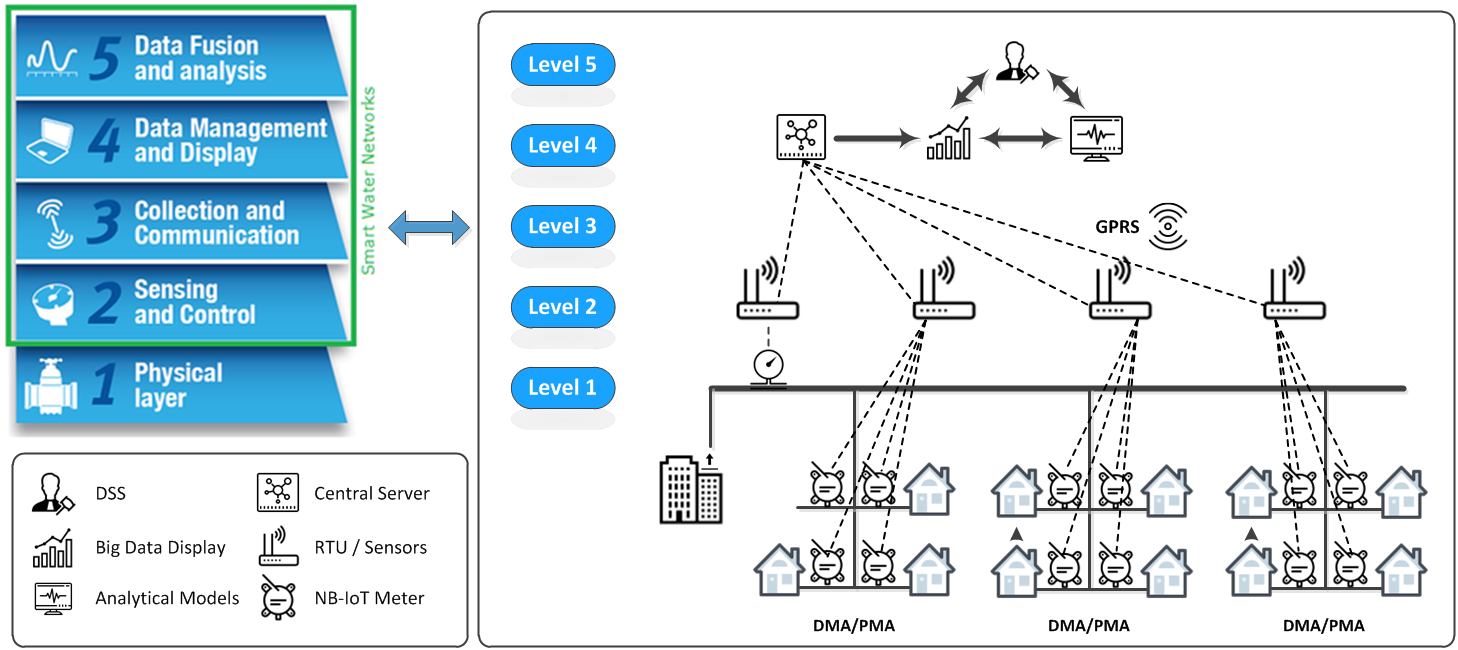
Towards Smart Water Systems
Posted on: October 2018Kourosh Behzadian
Towards Smart Water Systems
| About the author: Dr Kourosh Behzadian is Senior Lecturer in Civil Engineering at the school of Computing and Engineering at the University of West London. He is expert in Hydrosystems Engineering and Management and Operations Research, Chartered Civil Engineer and Chartered Water and Environmental Manager by CIWEM. |
|
 |
Pressure on limited water resources and frequent combined sewer overflow (CSO) spills due to external scenarios such as climate change and ever-increasing population growth, means that our water systems and infrastructure are under increasing pressure. This has led stakeholders to explore more efficient strategies for management of water resources and demand.
Thanks to the technological advancements in sensors, ICT (Information and Communication Technology) and IoT (Internet of Things), water systems can be integrated with these technologies to form a better performance against the above events. This new integration, known as smart water systems and its future look bright. Smart energy grids have been in place for a while now, smart water systems are at the beginning of their journey. However, there remain multiple key questions to be answered, some of which are: how smart water systems are defined; what benefits we should expect from these systems; how much smart water systems have achieved their targets; and what major steps are left for the future?
Smart water systems can be set up and analysed in various working components found in water supply, wastewater, and stormwater systems. Smart metering (meters that transfer instantaneous water use frequently across a day) is the first step of smart water supply systems and can provide multiple benefits. They increase social awareness about water use and provide comparison with local neighbours and average national use.
Auditing accurate smart metering by water utilities can also help facilitate water billing more accurately and cost-effectively and identify non-revenue water loss and illegal connections easily. By adding more sensors to other main components of water supply systems (e.g. pumps, service reservoirs, pressure reducing valves and main pipes) or sewer systems (e.g. CSO structure or rainwater harvesting tanks), water utilities can better visualise the real-time performance of the system and react more efficiently to system failures. Currently, these seem to be the main reasons for water utilities to deploy smart schemes. These sensors can also be coupled with actuators connected to the same components to adjust and control operation. This control requires a reliable mechanism that exchanges the data between sensors and receivers, then evaluates the real-time system performance and finally produces the best real-time settings of the system to be run by the actuators.

Fig.1 Interactive Architecture and Technology Layers of Smart Water Systems (drawn by Dr Qi Wang)
The key challenges in the technology levels for smart water system (as shown in Fig. 1) are technologies for data exchange, analytical models and overall integration. SCADA (Supervisory Control And Data Acquisition) is a traditional method for exchanging sensor data but it has multiple difficulties including restriction of limited bandwidth communication channel and others ranging from inconsistent data to problems involving time-logging. A SCADA system needs PLCs (Programmable Logic Controllers), HMI (Human Machine Interface) screens, database servers, large amounts of cables and wires, and some sort of software to bring all of these things together. Narrow Band-IoT (NB-IoT) offers deep coverage and massive connections with Low Power Wide Area wireless technology (LPWA) that are designed for machine communications and provide connectivity for devices and applications that require low mobility and low levels of data transfer. Due to the multiple technical benefits of using NB-IoT, it seems to be an ideal network communications technology for the smart water systems. Other technical benefits of NB-IoT include inherited networks (i.e. running on public networks), saving considerable amounts of time and money required for network construction, maintenance free by networks operators; and high reliability (achieving a meter reading success rate of over 99%).
The main functions of such smart water systems include the sensors in Level 2 (see Fig. 1) measuring the key features of the water systems in Level 1 (e.g. pressure in pressure logger, consumption in water meters, and pressure head in service reservoirs) and transferring to the data centre in Level 3 in which data are visualised and managed in Level 4. These data are processed by real-time analytical models and the best settings and timely measures are produced in Level 5 that will be sent back to Level 2 sequentially to actuating devices e.g. pressure settings in Pressure Reducing Valves (PRVs) and operation of pumps in pump station, fitted with the infrastructure. While all existing utilities have physical infrastructure (Level 1), some have the sensing part of Level 2 (e.g., pressure and flow sensors) and just a few have Level 3 technology (SCADA or GSM1 networks ) and Level 4 technology (visualisation of real-time sensors). Development of the Level 5 technology is a major challenge for almost all water utilities. This level enables effective integration of sensor data with modelling and forecasting tools for effective real-time control.
The future of smart water systems will focus more on the development of new IoT-based platforms integrating real-time data management with analytical models for improvement of real-time operation. It can be envisaged by further water loss reduction, better management of burst events, and more effective infrastructure rehabilitation. All this can be achieved by massive real-time data collection from sensors to monitor, process and analysis system performance by using hydraulic and meta-modelling tools and then setting control valves, operating pumps and controlling levels in reservoirs. Such a smart system needs to couple DSS (Decision Support System) with ICT and IoT technologies for integrated management and operation and a subsequent increase in water efficiency. Developing smart water systems based on IoT communications also has some concerns that need to be addressed. They include user’s privacy, reliability of data transmission, security of IoT modules, real-time modelling and forecasting tools.
1. Global System for Mobile communications



